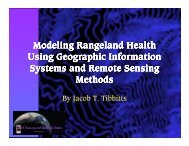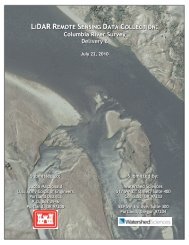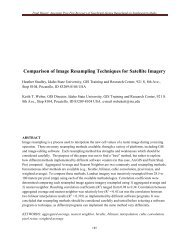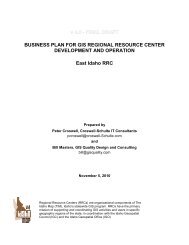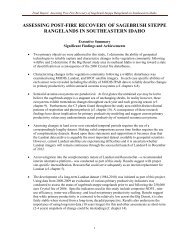A Multiscale Curvature Algorithm for Classifying Discrete Return ...
A Multiscale Curvature Algorithm for Classifying Discrete Return ...
A Multiscale Curvature Algorithm for Classifying Discrete Return ...
Create successful ePaper yourself
Turn your PDF publications into a flip-book with our unique Google optimized e-Paper software.
IEEE TRANSACTIONS ON GEOSCIENCE AND REMOTE SENSING, VOL. 45, NO. 4, APRIL 2007 1029A <strong>Multiscale</strong> <strong>Curvature</strong> <strong>Algorithm</strong> <strong>for</strong> <strong>Classifying</strong><strong>Discrete</strong> <strong>Return</strong> LiDAR in Forested EnvironmentsJeffrey S. Evans and Andrew T. HudakAbstract—One prerequisite to the use of light detection andranging (LiDAR) across disciplines is differentiating ground fromnonground returns. The objective was to automatically and objectivelyclassify points within unclassified LiDAR point clouds,with few model parameters and minimal postprocessing. Presentedis an automated method <strong>for</strong> classifying LiDAR returnsas ground or nonground in <strong>for</strong>ested environments occurringin complex terrains. <strong>Multiscale</strong> curvature classification (MCC)is an iterative multiscale algorithm <strong>for</strong> classifying LiDAR returnsthat exceed positive surface curvature thresholds, resultingin all the LiDAR measurements being classified as ground ornonground. The MCC algorithm yields a solution of classifiedreturns that support bare-earth surface interpolation at a resolutioncommensurate with the sampling frequency of the LiDARsurvey. Errors in classified ground returns were assessed using204 independent validation points consisting of 165 field plotglobal positioning system locations and 39 National Oceanic andAtmospheric Administration–National Geodetic Survey monuments.Jackknife validation and Monte Carlo simulation wereused to assess the quality and error of a bare-earth digital elevationmodel interpolated from the classified returns. A local indicatorof spatial association statistic was used to test <strong>for</strong> commissionerrors in the classified ground returns. Results demonstrate thatthe MCC model minimizes commission errors while retaining ahigh proportion of ground returns and provides high confidencein the derived ground surface.Index Terms—Classification, curvature, digital elevation model(DEM), filtering, <strong>for</strong>estry, interpolation, light detection and ranging(LiDAR), thin-plate spline, vegetation.I. INTRODUCTIONLIGHT detection and ranging (LiDAR) vendors have put<strong>for</strong>th substantial investment into developing ground identificationalgorithms. Un<strong>for</strong>tunately, most available algorithmsare proprietary and only available in commercial software orthrough “in-house” vendor postprocessing at considerable cost.A large portion of LiDAR survey cost is incurred during postprocessingto separate ground from nonground returns. Thisis in large part due to the manual editing required to “cleanup” the surface and the need to reclaim software developmentor purchase costs. Ground returns are often removed from thepoint cloud and delivered separately in the <strong>for</strong>m of a griddedManuscript received December 16, 2005; revised November 6, 2006. Thiswork was supported in part by the Rocky Mountain Research Station and inpart by industry partners Potlatch Inc. and Bennett Lumber Products, Inc.The authors are with the Moscow Forestry Sciences Laboratory, RockyMountain Research Station, USDA Forest Service, Moscow, ID 83843 USA(e-mail: jevans02@fs.fed.us).Digital Object Identifier 10.1109/TGRS.2006.890412raster or uni<strong>for</strong>mly spaced point data. Both of these deliverablesgeneralize the data, discarding the original spatial precision andvolume of sampled ground returns. The proprietary nature ofthese filtering methods and the <strong>for</strong>mat of provided data maketheir validation difficult. Furthermore, overfiltering, smoothing,or gridding ground returns compromises the original volumeof data, precluding analyses relying on relationships betweenground and nonground point volumes.Retaining a larger volume of ground returns will result inan interpolated ground surface more closely matching the scaleand precision of the original LiDAR point cloud [1] and willgreatly benefit any applications concerned with microtopography.Improved DEMs will in turn increase accuracy and precisionin the derived vegetation heights, benefiting vegetationmodeling applications. If the scale of an interpolated DEM iscommensurate with the LiDAR data, simply subtracting the interpolatedground elevation surface from the LiDAR elevationswill provide accurate vegetation heights at each point whilepreserving density relationships related to vegetation cover,such as the proportion of nonground to total returns [2].The majority of LiDAR classification approaches havedemonstrated utility in ground mapping or feature extraction(e.g., buildings) in urban environments. However, few solutionshave specifically addressed identification of nonground returnsin <strong>for</strong>ested environments. A few notable approaches have beenproposed <strong>for</strong> classifying LiDAR data in <strong>for</strong>ested environments[1], [3], but perhaps the most room <strong>for</strong> improvement in thequality of LiDAR-derived DEMs and subsequent vegetationcharacterizations lies in the initial classification of ground versusnonground returns [3]. Separating ground from nongroundreturns is challenging due to the convolution of ground andvegetation returns in the unclassified LiDAR point cloud. Classificationapproaches that overly smooth or reduce the volumeof ground returns (e.g., block minimums) are not well suited <strong>for</strong>many applications, which can benefit greatly from maximizingretention of ground returns while minimizing commission errors(labeling a valid nonground point as ground). An omissionerror (discarding a valid ground point) is less problematicthan a commission error in terms of influence on the interpolatedground surface. An automated and objective LiDARclassification algorithm that appropriately balances commissionomission errors will facilitate applications that exploit the 3-Dnature of LiDAR, particularly in <strong>for</strong>estry [4]–[9].Scale often has a profound effect on the behavior of landscapeobjects, such as trees. This is due to the topology of objectsthat do not behave in a uni<strong>for</strong>m linear manner across scales[10]. As an object is assessed across scales, it can split intomultiple objects, merge with other objects, persist, disappear, orU.S. Government work not protected by U.S. copyright.
1030 IEEE TRANSACTIONS ON GEOSCIENCE AND REMOTE SENSING, VOL. 45, NO. 4, APRIL 2007in the case of LiDAR, change its amplitude (deviation from surroundingpoints) [11]. All of these behaviors occur in LiDARpoint clouds as a classification/filtering model is applied.Changing object topology across scales argues <strong>for</strong> an iterativemultiscale model applied directly to the LiDAR point cloud.<strong>Algorithm</strong>s that identify nonground returns based on curvaturethresholds within local neighborhoods appear robust<strong>for</strong> separating ground from nonground in unclassified LiDARpoint clouds in <strong>for</strong>ested environments, particularly in complexterrain [3]. Previous attempts to account <strong>for</strong> slope and scaleeffects have used variable window sizes or weighting functionsto address the interactions of topography and vegetationon LiDAR returns [12]–[15]. However, these methods havebeen most effective <strong>for</strong> classifying nonground returns in gentleterrain, open canopy, or urban environments, rather than in,perhaps, the most challenging environment of densely <strong>for</strong>estedcomplex terrain.<strong>Curvature</strong> approaches identify positive local deviations fromsurrounding points and then iteratively classify them as nonground.Haugerud and Harding [3] presented a virtual de<strong>for</strong>estation(VDF) algorithm based on identifying positive localcurvatures in an interpolated triangulated irregular network(TIN) constructed from LiDAR point data. Once curvatures areidentified, TIN nodes that exceed a defined threshold are iterativelydeleted, and the model is run again with the remainingdata until a convergence threshold is met. Interpolation of TINmodels is based on a linear weighting function applied to avector connecting adjacent points [16]. In complex terrain, thiscan distort surface morphology, often resulting in large errors[17]. These commission and omission errors can add noise tothe surface, particularly in settings with steep slopes and highcanopy density.We present multiscale curvature classification (MCC), anautomated approach <strong>for</strong> classifying LiDAR returns that incorporatesthe strengths of curvature filtering [3], adds a scalecomponent in the interpolation phase, and a variable curvaturetolerance to account <strong>for</strong> slope interaction with the LiDARmeasurements [3]. The model iteratively classifies nongroundLiDAR returns that exceed positive curvature thresholds atmultiple scales. The three primary improvements of the MCCmodel on the VDF model are given as follows: 1) thin-platespline (TPS) interpolation [18], [19]; 2) integration of a multiscaleapproach where the surface is interpolated at differentresolutions; and 3) a progressive curvature tolerance. UnlikeTIN, TPS interpolation allows <strong>for</strong> adjustment of tension betweenpoints, providing adherence to input data and controllingthe distance at which point samples affect the surface estimates[20]. The spline tension parameter f also reduces large deviationsin the surface between sample points, effectively reducingnoise [20]. Inclusion of a multiscale approach more comprehensivelyaddresses topological relationships of nonground objectsacross variable scales. Because the surface is generalized asthe scale parameter is changed, it is necessary to change thecurvature threshold parameter, effectively addressing changesin slope effect as the data are generalized. In summary, MCCis an automated algorithm that iteratively identifies nongroundpoints that exceed positive curvature thresholds across multiplescales in unclassified LiDAR point clouds.Fig. 1.Location map of the two LiDAR survey areas and test sites.II. OBJECTIVESThe primary goal was to automatically, objectively, andconsistently identify ground returns from unclassified LiDARpoint clouds. Four criteria were applied in developing the MCCalgorithm. The first was flexibility across different LiDAR data<strong>for</strong>mats. The MCC algorithm requires only the X, Y , and Z coordinatesas inputs, the three most basic components commonto all discrete return LiDAR data sets. The second criterion wassimplicity in model parameters. Overly complex or numerousmodel parameters can introduce subjectivity or result in lackof repeatability. However, the only user-defined parameters inthe MCC algorithm are the initial scale and curvature toleranceparameters. The third criterion was that the model be fullyautomated, i.e., the user need not intervene during the classificationfiltering process, which can also introduce subjectivity.Finally, the algorithm should preclude or minimize the need <strong>for</strong>postprocessing, which can be a very time-consuming, costly,and subjective process. The MCC algorithm was designed toobjectively, reliably, and repeatability identify ground returnswith minimal to no need <strong>for</strong> manual postprocessing, fromany discrete return LiDAR data set acquired over a <strong>for</strong>estedenvironment.A. Study AreaIII. METHODSThe two LiDAR survey areas used in this paper, MoscowMountain and the Saint Joe Woodlands in north central Idaho(Fig. 1), comprise 88 000 ha of mixed conifer <strong>for</strong>est with amixture of industrial <strong>for</strong>est, private, state, and federal ownerships.Both areas are highly relieved with more topographiccomplexity in the St. Joe Woodlands. Conifer species vary fromPinus ponderosa at xeric sites to Tsuga heterophylla in mesicsettings. Other common conifer species include Abies grandis,Abies lasiocarpa, Larix occidentalis, Picea engelmannii,Pinus contorta, Pinus monticola, Pseudotsuga menziesii, andThuja plicata, which create diverse <strong>for</strong>est compositions acrossbroad temperature and moisture gradients. The canopy and age
EVANS AND HUDAK: MULTISCALE CURVATURE ALGORITHM FOR CLASSIFYING DISCRETE RETURN LIDAR 1033jackknife replicates (RMSE i ). Accuracy was assessed using thecumulative RMSE total across all jackknife replicates and theresidual error calculated by subtracting the withheld groundreturn heights from the corresponding height values in theinterpolated ground surface, as follows:RMSE total = √ (RMSE m ) 2 +(RMSE i ) 2 (4)where RMSE m is the RMSE of measured LiDAR elevationsand RMSE i is the RMSE of interpolated LiDAR elevations.Chrisman [25] refers to a raster surface as “a distributionof possible realizations in which the true value lies.” This isreferred to as a spatial random field or a stochastic image.Uncertainty in the DEM can be modeled by a set of realizationsof a spatial random field to provide a range of error that boundsthe “true” value [26]. To assess DEM quality, a Bayesian MonteCarlo approach was implemented by setting the distributionalpriors in each simulation to the range of the original DEM,with the addition of the vendor reported measurement error(0.106 m) defining the allowable standard deviation in therandom field [27]. One thousand Monte Carlo simulations wereconducted with replacement on the interpolated DEM. Residualerror was calculated in each simulation by generating a randomfield following the preceding criteria and applying a meanfilter to account <strong>for</strong> autocorrelated errors [26]. The originalDEM was then subtracted from the random field. RMSE (3)was calculated <strong>for</strong> each simulation condition, and the cumulativeRMSE was calculated across all 1000 simulations [28].Mapping cumulative RMSE allowed assessment of the spatialdistribution of uncertainty [26], [29].A local indicator of spatial association (LISA) statistic wasused on the classified ground returns within the two test sitesto identify commission errors based on discontinuities in thelocal autocorrelation [30]. A spatial weighting matrix was calculatedusing the six nearest neighboring ground returns and theassociated local autocorrelation value calculated at each point.Spatial outliers were identified, and the neighborhood deviationfrom the mean using these six nearest neighbors was calculatedto determine the magnitude of the potential error.Finally, visual inspection was used in conjunction with theresults of the LISA statistic to assess overall surface qualityand examine potential commission errors, which are apparentvisually due to their obvious discontinuity from the surroundingsurface when viewed in shaded relief.Fig. 3. Percent of returns classified in each of the three scale domains of MCCoperation in the transitional <strong>for</strong>est test site.TABLE INUMBER OF TOTAL LIDAR RETURNS AND NONGROUND AND GROUNDRETURNS CLASSIFIED AT THE TWO SELECTED TEST SITESIV. RESULTSA. Model Per<strong>for</strong>manceThe curvature tolerance parameter t was sensitive to slopeeffects and λ and there<strong>for</strong>e was tested on a subset of the data todetermine the best starting value. In this paper, initial parametersof λ =1.5 and t =0.3 consistently identified nongroundreturns. The majority of nonground returns were identified inthe first scale domain; the volume of additional nongroundreturns identified in subsequent scale domains asymptoticallydeclined (Fig. 3, Table I). Processing the returns across threescale domains (Fig. 4) was sufficient to classify nongroundreturns while minimizing omission errors.Fig. 4. Shaded relief of interpolated classification results at four stages ofMCC operation in each scale domain at the dense <strong>for</strong>est test site. (a) Preclassified.(b) Convergence in scale domain 1. (c) Convergence in scale domain 2.(d) Convergence in scale domain 3 (final result). The largest potential commissionerror is indicated by the arrow.B. Assessment of Interpolators Within MCCIn the testing of different interpolation methods within theMCC model, TPS was the best interpolator of the four alternativesconsidered (Table II; Fig. 6). Ordinary Kriging producedthe poorest fit to the unfiltered point clouds and caused somesurface erosion [Fig. 6(a)], and proved to be overly processorintensive and unrealistic to implement due to difficulty
1034 IEEE TRANSACTIONS ON GEOSCIENCE AND REMOTE SENSING, VOL. 45, NO. 4, APRIL 2007TABLE IIFORESTED TEST SITE JACKKNIFE RMSE AND RESIDUAL ERROR RANGES(IN METERS) OF FOUR INTERPOLATION METHODS TESTED IN THE MCCMODEL FOR INTERPOLATING UNCLASSIFIED LIDAR RETURNSTABLE IVRESIDUAL ERROR DISTRIBUTION STATISTICS (IN METERS)ACROSS 100 JACKKNIFE REPLICATES IN EACH TEST SITETABLE IIIRESIDUAL ERROR STATISTICS AND RMSE (IN METERS)BETWEEN DEMsINTERPOLATED FROM CLASSIFIED LIDAR GROUND ELEVATIONSAND TWO INDEPENDENT VALIDATION DATA SETSlocations with level B or better vertical control produced aRMSE of only 0.04 m across the two LiDAR survey areas.in automatically and consistently fitting semivariogram functionsthroughout model iterations. Inverse distance weightingintroduced curvature artifacts that resulted in dramatic errors,in some cases misclassifying entire hill slopes as nonground[Fig. 6(b)]. TIN maintained exact values at the sample locationsbut produced large deviations between LiDAR sample points,and significantly eroded some hillslopes [Fig. 6(c)]. The TPSproduced the best fit to the unclassified LiDAR data (Table II)and was the only interpolator that did not erode the groundsurface [Fig. 6(d)].C. ValidationThe range and standard deviation of the field GPS residualswere higher than those from the NGS monument residuals. Thisis most likely due to NGS monument locations predominatelyoccurring in valley bottoms or on ridge tops with little canopycover, while the field GPS plots mainly occurred beneathdense canopy, which diminishes field GPS accuracy. The NGSmonument elevations were expected to be much more accuratethan the nonsurvey grade field GPS elevations, although only5 of 39 NGS monuments had a vertical accuracy of < 1cm(i.e., level B or better vertical control). Across both study areas,the mean residual error was −0.695 <strong>for</strong> the GPS locationsand 0.601 <strong>for</strong> the NGS monuments (Table III). These aresmall biases considering the large magnitude of some outliers(especially in the field GPS elevations) that inflated the residualerror and RMSE [24], [31].RMSE alone failed to provide in<strong>for</strong>mation about the residualerror distributions, such as the balance between small and largedeviations, and skewness [32]. The frequency distribution of theresiduals can be used to indicate the direction and magnitudeof a bias [16], uncovering possible systematic or conditionalsources of error. In this paper, the median values of zero in boththe field GPS plot and NGS monument residual distributions(Table III) suggested little bias in the classified ground returns.Limiting the NGS monument validation data to just the fiveD. EvaluationResults from the jackknife validation indicated that theRMSE total in the dense <strong>for</strong>est test site was 0.306 and 0.166 inthe transitional <strong>for</strong>est test site. The slightly higher RMSE totalin the dense <strong>for</strong>est test site can be attributed to steeper slopesand denser canopy, excluding ground returns. Analysis of theresidual error across all jackknife replicates demonstrated normallydistributed errors (Table IV) in both test sites, indicatingminimal directional bias in the distribution. The mean residualerrors in the dense <strong>for</strong>est and transitional <strong>for</strong>est test sites were−0.0081 and 0.0407, respectively, indicating very small biases.The mean and median nearly match, indicating a symmetricerror distribution (Table IV). The standard deviation (Table IV)is consistently quite small, showing a constrained range of error.A bivariant q–q plot of interpolated versus measured values (notshown) showed the same distributional shape and variance inboth test sites, all supporting a very good model fit.Monte Carlo simulation identified areas with higher uncertaintythat represent strong slope curvatures, commissionerrors, or areas with comparatively high sample density. Subtlehorizontal bands in the RMSE surface of <strong>for</strong>ested areas [moreobvious at the dense <strong>for</strong>est test site, Fig. 6(a)] coincided withoverlapping flight lines, where the sampling density was effectivelydoubled. Although it seems counterintuitive that a highersample density should increase the RMSE, this could be relatedto areas of higher sample density causing greater fine scalevariability than surrounding areas.Two landscape features produced unusually high RMSE(∼3 m) in the transitional <strong>for</strong>est test site. The first is a building[circle 1 in Fig. 6(b)]. The second is a small <strong>for</strong>ested knollwith a drainage ditch directly adjacent [circle 2 in Fig. 6(b)].Although the nonground returns were successfully removedfrom the knoll, the juxtaposition of the knoll and ditch created alocal area of higher uncertainty. With these two exceptions, thesimulation results indicated high confidence in the DEMs andidentified no areas exhibiting extreme uncertainty.The LISA statistic effectively identified potential commissionerrors and allowed the evaluation of the magnitude ofeach error. The largest potential commission error identified atthe dense <strong>for</strong>est test site consisted of two points that deviatedfrom the mean of the six nearest neighbors by 5.96 m and isapparent upon close visual inspection of the interpolated DEMsurface (Fig. 4). This potential commission error and others less
EVANS AND HUDAK: MULTISCALE CURVATURE ALGORITHM FOR CLASSIFYING DISCRETE RETURN LIDAR 1035Fig. 5. Be<strong>for</strong>e and after shaded relief of the interpolated surface of all returnsand ground returns from the transitional <strong>for</strong>est test site. A commission errorcaused by a building is indicated by the arrow.pronounced could be real nonground features of the landscape(e.g., stumps or woody debris) that the MCC model failed toeliminate. In the transitional <strong>for</strong>est test site, the same buildingalready mentioned caused the largest commission error, consistingof six points that deviated from the mean of the six nearestneighbors by 8.06 m (Fig. 5).algorithm to identify and remove such edge features woulderode or remove road and stream bank cuts. Since this algorithmis designed <strong>for</strong> <strong>for</strong>ested landscapes where road cuts typically faroutnumber buildings, retention of these features is imperative.Morphological filters have been shown to be effective <strong>for</strong>removing buildings [15], and future research should explore thepossibility of combining multiple classification approaches toexploit the strengths of each.A few other limitations of the MCC model need to beaddressed. Processing time is a current drawback to implementationof the MCC model. Fitting splines on high volumes ofdata is very time and processor intensive, and there is muchroom <strong>for</strong> improvement. Mitasova et al. [20] propose a splinemodel that uses quadtree segmentation <strong>for</strong> handling large datavolumes and appears to be quite promising. Implementation ofMCC in a more efficient language than AML and integrationof the quadtree approach [20] would dramatically improve thespeed and efficiency of the model. In the LiDAR data used inthis paper, an attribute indicating “last return” was not providedso it was not considered in the implementation of the model.Running the model on last returns would increase speed byreducing the overall volume of the data.V. D ISCUSSIONA. Model Per<strong>for</strong>manceVegetation density largely determines the ratio of ground-tovegetationreturns. The contrast between the vegetation structuresand the selected test sites is evident in the percentagesof ground and nonground returns identified (Table I). The vastmajority of nonground returns are removed within the first scaledomain (Figs. 3 and 4). By starting the first scale domain with acell size of approximately half the postspacing, the MCC modelfirst removes those returns producing the highest curvatures at afiner resolution. As nonground points are removed, the remainingdata become more generalized. In the next scale domain,the scale parameter changes to a larger cell size, effectivelycompensating <strong>for</strong> this smoothing of the data and thus changingthe resulting surface topology. Since the curvature toleranceparameter compensates <strong>for</strong> slope effect (which increases asresolution coarsens), the sensitivity of the curvature toleranceparameter changes as well. After the first few iterations of themodel within a given scale domain, most extreme curvaturesare classified, and each subsequent iteration further refines theclassification results. After the first scale domain converges,the majority of large surface curvatures have been classified,and subsequent scale domains, in effect, smooth small surfacemodulations created by low understory vegetation and grounddebris. In summary, the scale and curvature tolerance parameterswork in concert to account <strong>for</strong> changes in the topology ofobjects in the point cloud as nonground returns are removedfrom consideration. Varying the scale and curvature toleranceparameters in the MCC algorithm robustly addresses variablecanopy configurations interacting with slope, as manifested inthe LiDAR point cloud.Abrupt edge features (e.g., buildings) typically will notexceed the positive curvature thresholds used by the MCCalgorithm to identify nonground returns. Reconfiguring theB. Interpolators Within MCCWhile TPS clearly outper<strong>for</strong>med the other interpolatorstested within MCC (Table II), further investigation of the influencesof tension and smoothing in TPSs may provide moreflexibility across a large range of LiDAR data sets [20]. Threescale domains were adequate <strong>for</strong> good model per<strong>for</strong>mance inthis study, but different <strong>for</strong>est structures or LiDAR acquisitionparameters (i.e., very dense post spacing) may require changesin the curvature threshold parameter and/or the number of scaledomains required.C. ValidationA variety of validation methods were chosen in this paperto more rigorously evaluate the per<strong>for</strong>mance of the MCC algorithmand quality of the derived DEM. Many factors influencethe creation of a DEM, including the interpolation method,resolution, and sampling error. Further consideration of thesefactors was beyond the scope of this paper but have beenaddressed by Smith et al. [23], [33]. The idea of using a derivedDEM surface as a proxy <strong>for</strong> classification quality has beenintroduced in previous research [34] as a means of validatingthe large volume of data that LiDAR surveys provide. Lewisand Hutchinson [35] empirically demonstrated that the detailsof the probability distribution of spatially correlated errors arefar less important in determining data quality than the inherentquality of the derived surface.The intention of including the nonsurvey grade field GPSand NGS control validation points was not to assess localaccuracy but to identify any global bias in the classified groundelevations across a number of independent validation points.The vertical error residuals from the GPS and NGS validationmay be primarily random, given that the median errors werezero (Table III), which supports the idea of assessing global
1036 IEEE TRANSACTIONS ON GEOSCIENCE AND REMOTE SENSING, VOL. 45, NO. 4, APRIL 2007Fig. 6. Shaded relief’s comparing different interpolators within MCC.(a) Ordinary Kriging. (b) Inverse distance weighting. (c) Triangular irregularnetwork. (d) TPS.bias using validation data less accurate than the LiDAR data[36]. If a representative validation sample were to be calculatedbased on the number of observations in the LiDAR, the numberof field samples required <strong>for</strong> 95% confidence intervals wouldbe virtually impossible to acquire [37], precluding many traditionalvalidation techniques.D. EvaluationLess understory vegetation and surface clutter will increasecertainty in the ground estimate, as demonstrated by the MonteCarlo simulations (Fig. 6). Including the LiDAR measurementerror in the total RMSE reported <strong>for</strong> the jackknife validationand Monte Carlo simulation results more honestly reflects thecumulative error in the estimate of ground elevation and moreconservatively assesses the accuracy of the derived DEM. TheLISA point pattern statistic provides an unbiased empiricalmethod <strong>for</strong> validating the classified ground points and quantifyingthe magnitude of identified errors. The results illustratethat potential commission errors are kept to a minimum(Figs. 4 and 7). Potential commission errors can vary from lowamplitude errors representing understory vegetation to entirenonground objects that the model fails to identify [3], [15].Some level of surface modulation is to be expected in <strong>for</strong>estedareas due to low understory vegetation, logs, stumps, and otherground debris [3].Commission and omission errors play an important role inLiDAR point classification. Omission errors are more difficultto observe and quantify than commission errors. However, if occurringin moderation omission errors has less influence on thequality of the resulting DEM. Generally, the results indicatedno severe biases in classified ground returns, either globally(Table III) or locally (Table IV, Figs. 4 and 7), suggesting thatMCC appropriately balanced commission and omission errors.The definition of “ground” is application and scale dependent,making it easy to disconnect the resolution of an interpolatedDEM surface estimate from the resolution of theLiDAR sample data. Block minimums are a clear example of aFig. 7. Cumulative RMSE from 1000 Monte Carlo simulations in (a) the<strong>for</strong>ested test area and (b) transitional <strong>for</strong>est test area. The RMSE range portrayedin the legend in (b) excludes two features (indicated by white arrows)that produced the RMSEs of ∼3m.LiDAR filtering strategy that can potentially disconnect a surfaceestimate from the resolution of the LiDAR sample data.Increasing the block size to identify the minimum groundheight effectively smoothes the data to a resolution that iscoarser than the LiDAR sampling frequency. This produces acontiguous grid of ground estimates that is consistently derivedacross the landscape, which may be convenient <strong>for</strong> some applications,but is decoupled from the highly variable nongroundsamples that are of primary interest <strong>for</strong> many applications. Themore sophisticated MCC classification strategy is most suited<strong>for</strong> <strong>for</strong>ested landscapes with or without complex terrain. TheMCC algorithm is efficient in that it maximizes the number ofclassified ground returns, making it an attractive algorithm <strong>for</strong>a variety of applications.VI. CONCLUSIONThe complex vertical arrangement of LiDAR data requiresan iterative processing approach to converge on an accuratesolution of identified nonground returns. The multiscale facetof the MCC model is perhaps its most useful innovation. Byaddressing topologic differences across scales [10], MCC effectivelyidentifies nonground returns in the vertical distributionof elevations in the LiDAR point cloud. The dynamic scaleand curvature tolerance parameters work in concert to account<strong>for</strong> changes in the topology of objects in the point cloud as
1038 IEEE TRANSACTIONS ON GEOSCIENCE AND REMOTE SENSING, VOL. 45, NO. 4, APRIL 2007[34] T. L. Webster, “LiDAR validation using GIS: A case study comparisonbetween two LiDAR collection methods,” Geocarto Int., vol. 20, no. 4,pp. 1–9, 2005.[35] A. Lewis and M. F. Hutchinson, “From data accuracy to data quality:Using spatial statistics to predict the implications of spatial error inpoint data,” in Quantifying Spatial Uncertainty in Natural Resources,H. T. Mowrer and R. C. Congalton, Eds., Chelsea, MI: Sleeping Bear,2000, pp. 17–35.[36] R. C. Daniels, “Datum conversion issues with LiDAR spot elevations,”Photogramm. Eng. Remote Sens., vol. 67, no. 6, pp. 735–740, 2001.[37] Z. Li, “Effects of check points on the reliability of DEM accuracy estimatesobtained from experimental test,” Photogramm. Eng. Remote Sens.,vol. 57, no. 10, pp. 1333–1340, 1991.Jeffrey S. Evans received the B.S. degrees in ecologyand statistics from the University of Cali<strong>for</strong>nia,San Diego, in 1990 and the M.S. degree inornithology and biogeography from the University ofCali<strong>for</strong>nia, Berkeley, in 1994.He has been a Landscape Ecologist with theMoscow Forestry Sciences Laboratory, RockyMountain Research Station, USDA Forest Service,Moscow, ID, since 1999. His research interestsinclude spatial interactions in ecological systems,spatial statistics, scale, and using remote sensingand GIS to model wildlife and vegetation dynamics. His current researchinterests include <strong>for</strong>est structural modeling using LiDAR, scale and samplingrelationships between LiDAR and field measurements, multiscale predictivevegetation modeling, spatial variability of fire severity, and landscape genetics.Andrew T. Hudak received the B.S. degree in ecology,evolution, and behavior from the Universityof Minnesota, Minneapolis, in 1990 and the Ph.D.degree in environmental, population, and organismicbiology from the University of Colorado, Boulder,in 1999.Since 2001, he has been a Research Forester withthe Moscow Forestry Sciences Laboratory, RockyMountain Research Station, USDA Forest Service,Moscow, ID. His general research interest is developmentand application of novel approaches <strong>for</strong> extractinguseful ecological in<strong>for</strong>mation from remotely sensed data <strong>for</strong> the benefit ofecologists and managers. His current research interests include remote sensingof canopy structure and composition, wildfire effects, and vegetation change,across <strong>for</strong>est and rangeland landscapes.





